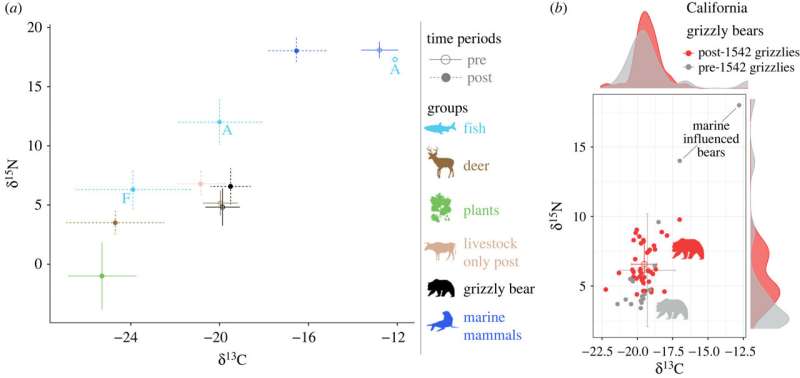January 10, 2024 report
This article has been reviewed according to Science X's editorial process and policies. Editors have highlighted the following attributes while ensuring the content's credibility:
fact-checked
peer-reviewed publication
trusted source
proofread
California grizzlies were smaller in size and not the livestock killers reported in historical accounts, study says

A team of biologists, historians, and Earth and environmental scientists affiliated with multiple institutions in the U.S. has found evidence that contradicts historical accounts of the size and feeding habits of the now-extinct California grizzly bear. In their project, reported in the journal Proceedings of the Royal Society B, the group studied preserved bones and pelts from California grizzly bears and compared their results with historical records.
The California grizzly (a subspecies of brown bear) lived in many parts of California when European settlers arrived. Over time, the bears gained a reputation as massive beasts, some weighing as much as 1,000 kilograms, that would attack humans and feed on livestock. Their reputation led to settlers hunting them to extinction. The last known California grizzly bear was documented in 1924. In this new effort, the research team sought to find out whether the reputation of the California grizzly was warranted.
The work involved testing bones and pelts kept by individuals, groups and museums in two ways. The first involved studying nitrogen and carbon isotopes in the remains to learn more about the diet of the bears. They found that the bears were mostly vegetarian, both before and after the arrival of settlers—their diets were typically made up of just 9% meat. The team then measured the size of bones and pelts and determined that the average weight of the bears was approximately 200 kg, which they state is near the average weight of grizzly bears now living in other parts of North America.
The researchers note that some grizzlies did begin to eat more meat, specifically livestock, after European settlers arrived, encroaching on their territory. But even then, meat still made up just a quarter of their diet. They conclude that problems created by the California grizzly were likely inflated by settlers and hunters looking to make a name for themselves by tracking and killing the bears and mounting the very largest specimens.
More information: Alexis M. Mychajliw et al, Coupled social and ecological change drove the historical extinction of the California grizzly bear ( Ursus arctos californicus ), Proceedings of the Royal Society B: Biological Sciences (2024). DOI: 10.1098/rspb.2023.0921
Journal information: Proceedings of the Royal Society B
© 2024 Science X Network

















